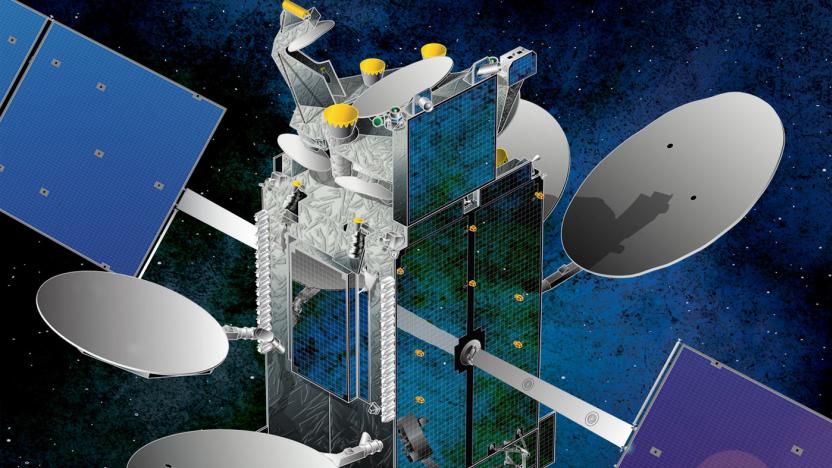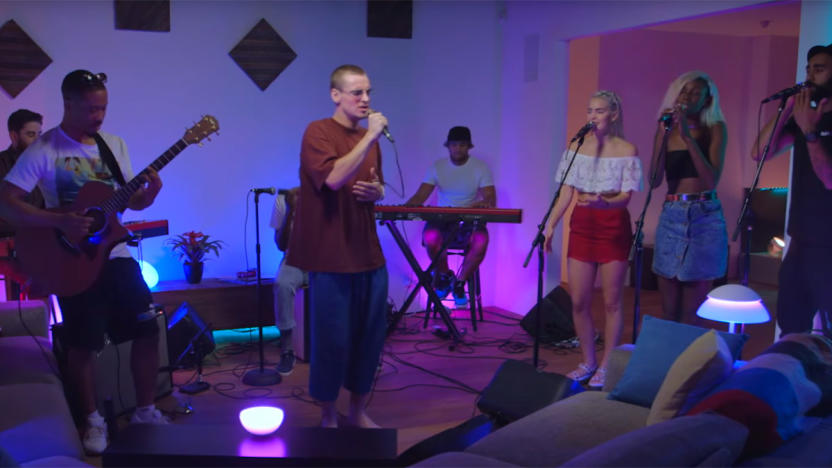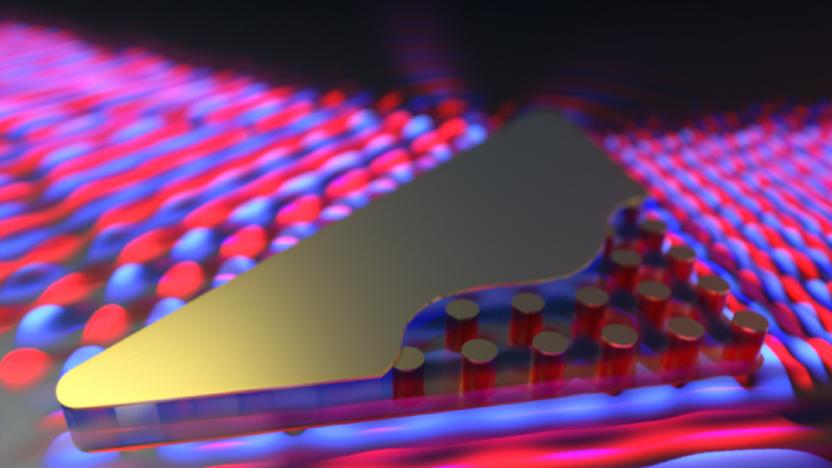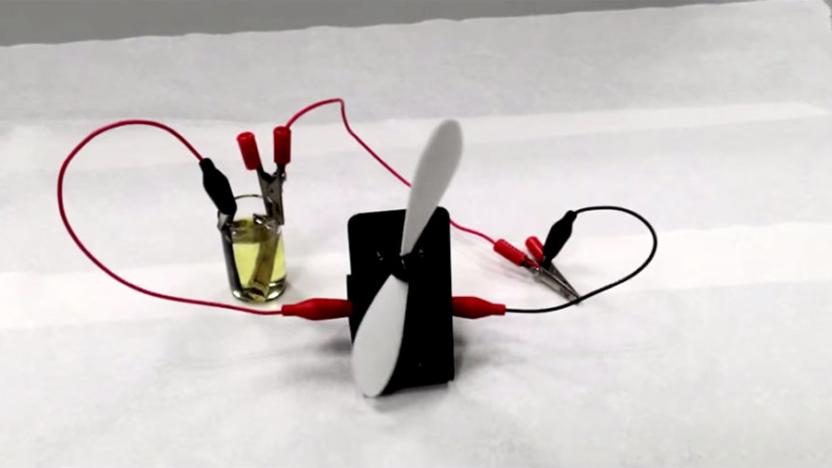light
Latest

New form of light could make fiber optics more secure
When light hits your eyeball, the spinning photons actually twist it (infinitesimally). The force of that spin, known as angular momentum, has always been thought to be a direct multiple of a quantum physics number called Planck's constant. However, scientists from Trinity College Dublin discovered a form of light with an angular momentum that's exactly half that amount. Though that may not sound like a big deal, the discovery could have "real impact on the study of light waves in areas such as secure optical communications," says Professor John Donegan.

Researchers use light and genes to fight cancer
Scientists have already shown that you can use optogenetics (that is, light-sensitive genes and cells) to treat all kinds of medical conditions. However, it now looks like that technique could conquer one of humanity's biggest nemeses: cancer. Tufts University researchers have successfully used optogenetics to prevent and even reverse tumor growth in experiments. They injected frog embryos with genes that produced light-sensitive ion channels in tumor cells; when you expose those tumors to blue light for long enough (roughly a day) and adjust their electrical signals, they go away.

Blind woman may see thanks to gene therapy and light
Optogenetics, or mixing gene therapy with light treatments, is finally getting a proper field test: doctors have given a blind Texas woman the first optogenetics-based therapy in hopes of restoring some of the vision lost to a degenerative retina disease. The procedure injected her eye with viruses containing DNA from light-sensitive algae, letting them mimic the eye's rods and cones by generating electricity whenever they're subjected to light. The patient won't get full vision even if the therapy is a runaway success, but it could be enough to let her know when there's nearby activity.

Philips' latest Hue lights help you sleep
Philips has smart Hue light bulbs that produce flashy colors, but what about bulbs that change just enough to give you a good night's rest? You're set after today. The lighting firm is trotting out Hue white ambiance lights that offer color temperatures which mimic natural light, helping you sleep naturally. Combined with new "routines" in an upcoming version of the Hue app, they can shift gradually to reflect day and night cycles -- a sleep mode can use dimming light to replicate the sunset, for example, while "wake up" brightens the area. There's even a nightlight mode to help kids get back to sleep after wandering the hallway. Logically, the new Hue offering should also be useful for creating different moods. You could have cool, crisp lighting in a workspace, or warmer temperatures in the living room.

NASA is making a data modem driven by light
Now that photonic (that is, light-based) chips are a practical reality, they're going to get their ultimate test: space. NASA is developing an integrated photonics modem that will be used to test high-speed laser communications between Earth and spacecraft that are in low and geosynchronous orbits. And unlike the LADEE laser data test from 2013, this is very much intended for practical use -- the Laser Communications Relay Demonstration (LCRD) should be fully operational two years after its initial deployment.

Light-triggered nanoparticles kill drug-resistant bacteria
Many current attempts at killing drug-resistant "superbugs" amount to racing against time, whether it's improving research technology or developing germ-fighting techniques that are less likely to promote resistance. That's not really an effective long-term strategy, is it? However, University of Colorado scientists might have a more permanent solution. They've developed light-triggered nanoparticles (specifically, quantum dots) that can kill stubborn bacteria on demand. They're dormant when it's dark, but shining the right light wavelength will make the particles attack infected cells. And unlike metal nanoparticles, they won't inadvertently wreck healthy cells in the process.

Efficient incandescent bulb cannibalizes its own waste heat
A team of researchers from MIT announced Monday that they have developed a novel method to make conventional incandescent lights far more energy efficient. Incandescents, the ones with the white hot filament in the middle, are notorious energy hogs because they generate massive amounts of waste heat in addition to light.

Researchers show off a working light-based processor
The year has been chock-full of scientific breakthroughs, but the University of Colorado is determined to finish 2015 with a bang. Its researchers have created what they say is the first full-fledged processor to transmit data using light instead of electricity. The design isn't entirely photonic, but its 850 optical input/output elements give it the kind of bandwidth that make electric-only chips look downright modest -- we're talking 300Gbps per square millimeter, or 10 to 50 times what you normally see. The key was finding a way to reuse existing conventional processes to put optics in places where regular circuitry would go.

Philips Hue won't work with third-party light bulbs for now
Bad news if you're planning to slip a few non-Philips light bulbs into your Hue setup: they won't work, at least not for a while. Philips has dropped support for third-party bulbs after noticing that a growing number of them had "interoperability issues" preventing them from playing nicely with official Hue gear. Support will come back, but only through a Friends of Hue program that will certify lighting. Any existing lights you're using will work, Philips is quick to note -- it's only new, untested additions that are getting the boot.

This 'Plant Lamp' uses bacteria to generate electricity
Maintaining infrastructure in the rainforest is a pretty tall order -- the area is dense with vegetation and prone to intense moisture and flooding. Villages like Nuevo Saposoa in Peru have had their electrical grids disabled or destroyed by the elements, leaving residents at the mercy of daylight or the fumes of kerosene lamps to work, read or study. Researchers at Peru's Universidad de Ingeniería y Tecnología have created a novel solution: an LED lamp powered by a houseplant.

LED implants could ease your pain
One day, eliminating pain may just be a matter of flicking on a light. Scientists have shown that you can implant LEDs that stop neurons from firing and cut out pain reception. The current technique (tested in mice) requires altering the neurons' DNA -- you couldn't just stick them in anyone. They're soft, however, and safe enough that you can leave them under the skin for long periods of time without limiting motion or wrecking tissue.

Experts say phones need a 'bedtime mode' to fix our sleep
We've all done it: you've gone to bed early in order to catch up on some much needed sleep, only to lay there for hours staring at your phone until you're no longer tired. Some reports believe handsets shouldn't get all the blame for our poor sleep schedules, but we've known for some time that those glowing displays aren't helping. The best solution would be to turn devices off before going to bed, but leading sleep experts are also calling for device makers to include an automatic "bedtime mode" to help us drift off easier at night.

Watch Philips and Rudimental meld smart lighting with music
If you were making connected lighting, how would you convey the concept to the public? Philips thinks it has a way. It just launched the Living Light Sessions, a series of performances that has musicians putting on a light show with Hue bulbs while they play. The music is great, as an inaugural video from UK outfit Rudimental shows, although the link between music and smart lights is a bit strained -- while Hue is supposed set a "laid-back mood" for the gig, it mostly amounts to a lot of blue and purple in a studio. If nothing else, though, this could serve as a friendly reminder that Philips' technology is good for more than just impressing your friends.

Scientists made the blackest material ever
Scientists may have made a breakthrough in materials that can help manipulate light at nanoscale, but is it really, really, really black? No. Researchers at Saudi Arabia's King Abdulla University of Science and Technology have created a carbon-nanotube material that absorbs 98 to 99 percent of light (at all angles) between 400 and 1,400nm. But there's actually a reason why something that black needs to exist. These absorbers take on important roles when it comes to solar power absorption and optical interconnects, where fiberoptic data is being passed around. Researchers were able to put a small concentration of their special nanoparticles into a solution, which gave 26 percent more absorption than carbon nanotube -- the previous prince of (material) darkness. For now, there's none more black.

Harvard creates a material that lets light go 'infinitely fast'
Researchers at Harvard University announced recently that they had successfully developed a means of manipulating light at the nanoscale, which could lead to photonic-based (rather than electronic) telecommunications. Think, ubiquitous fiber optics. The team reportedly developed an on-chip metamaterial made from silicon pillars embedded in polymer and wrapped in gold film that exhibits a refractive index of zero. In English, that means that the phase of light passing through this material can travel infinitely fast without violating the known laws of physics.

Disney explains why its 3D animation looks so realistic
Have you watched 3D-animated Disney flicks like Big Hero 6 and wondered how some of its scenes manage to look surprisingly realistic? Today's your lucky day: Disney has posted a top-level explanation of how its image rendering engine, Hyperion, works its movie magic. The software revolves around "path tracing," an advanced ray tracing technique that calculates light's path as it bounces off objects in a scene. It takes into account materials (like Baymax's translucent skin), and saves valuable time by bundling light rays that are headed in the same direction -- important when Hyperion is tracking millions of rays at once. The technology is efficient enough that animators don't have to 'cheat' when drawing very large scenes, like BH6's picturesque views of San Fransokyo. Although Disney's tech still isn't perfectly true to life, it's close enough that the studio might just fool you in those moments when it strives for absolute accuracy.

LG's new touchscreens will make your next laptop thinner and lighter
LG's display subsidiary is promising drastically thinner, lighter touchscreens that will be ready for notebooks later this year. With full HD (1080p) resolution, the Advanced In-Cell Touch (AIT) screens substitute a touch panel layer for a touch sensor built into the LCD itself -- that's what makes it thin. It's the same tech found in smartphones like LG's own G4, but this is the first time it's been sized up to laptops. Thickness savings will be around 25 percent, while weight reductions could be as much as 35 percent compared to typical laptop touchscreen. That reduction in layers also translates to less light reflection, which LG Display reckons will make the new screens brighter and clearer. The company plans to roll out multiple sizes, with stylus-compatible models also on the way. If these screens are going to shave the profile of your next Ultrabook even further, there might be no other choice but to go with a few of those oh-so-slender USB-C ports.

Artists paint light using 3D printers and twisted video walls
Who said that you had to paint light by waving an arm around? Certainly not Ekaggrat Singh Kalsi and Daniel Canogar, both of whom have created art using some decidedly unusual tech. Kalsi's project generates floating color portraits thanks to a modified 3D printer -- as you'll see in the clip below, it's akin to forming a hologram line by line. Canogar's work, meanwhile, uses twisted, mobius-like LED tiles as video walls that produce unique (and occasionally mind-bending) effects at different angles. You probably won't see these pieces in person, but they're proof that light-based art holds a lot of untapped potential.

Tiny house uses light to put you in the middle of a thunderstorm
Standing in a greenhouse and listening to the rain thunder against the roof can be strangely relaxing and therapeutic. Now, imagine if the same experience was recreated artificially. For the Triennale Der Photographie exhibition in Hamburg, designer Leigh Sachwitz has constructed a miniature house covered with semi-transparent projection screens. Once you step inside and turn off the hanging bulb, a series of projectors spring to life and batter you with heavy weather, including tornadoes and tropical thunderstorms. The dynamic sounds are recreated with speakers, but it's the projectors -- four on the inside, with another two cutting through a haze machine on the outside -- that really bring the installation to life. Circles quickly appear and disappear to recreate raindrops, while streaks of diagonal light imitate heavier downpours. It's not a particularly accurate art piece, but in terms of capturing atmosphere and mood, "INSIDE OUT" feels pretty spot on.

Light-based battery makes its own power
Sure, you can make solar-powered devices that store their excess energy in a battery, but what about the battery itself? Unfortunately, it's still behind the times -- the lithium-ion cells you see today have to be connected to another device to charge, and they're occasionally very dangerous thanks to their chemical makeup. A team of Indian researchers may have just licked those problems, though. They've developed a battery whose titanium nitrate anode (where current flows into the device) is driven by light, both natural and artificial. In a well-lit area, a prototype can recharge itself without using either an external source or unstable chemicals.






